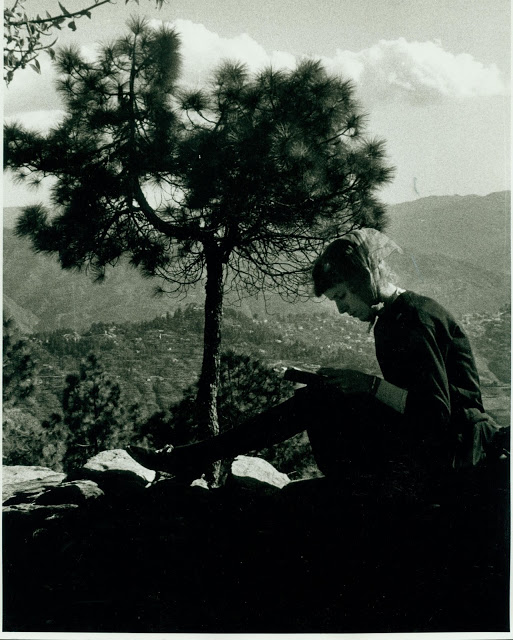Joanne in the Himalayas 1962, photo by Allen Ginsberg
e-mail to Linda Russo from Ron Silliman
From: rsillima@ix.netcom.com
Date sent: Tue, 28 Apr 1998 05:00:30 -0500 (CDT)
To: lvrusso@acsu.buffalo.edu
Subject: Re: Silliman on Kyger
On 04/27/98 20:10:48 you wrote:
>
>Dear Ron Silliman --
>
>you maybe recognize as a sometime poetix listperson --
>
>i've been only skimming posts lately (busy) but I was wondering if you
>could say more abt. Joanne Kyger being the most influencial progressive
>woman poet of the 60s - 70s. She's been important to me & it does seem,
>considering the scope of her work, that she *should* be important, but
>doesn't seem so considered. So i wonder if you'd be willing to tell me a
>thing or two, or maybe point me to something you've published re kyger.
>
>thanks --
>
>Linda Russo
Dear Linda,
Been thinking about this myself over the past few days. Kyger's not in the [Paul] Hoover [anthology Postmodern American Poetry] or the [Douglas] Messerli [anthology From The Other Side of the Century] and absent even from Moving Borders [ed. Mary Margaret Sloan], an anthology I imagine as having been premised on precisely this sort of omission (though I argued over this with Margy Sloan, who simply doesn't know the work and doesn't have the historical depth I wish she had -- she told me that she was only using writers from the late '70s onward, so I was surprised to see Niedecker, Guest and Fraser, all of whom are contemporaneous with Joanne or, in Lorine's case, even earlier).
Joanne Kyger was a student of Hugh Kenner's at UC Santa Barbara in the 1950s who moved to SF where she became the only woman to participate as an equal in the otherwise remarkably misogynist Spicer circle. She married Gary Snyder and traveled with him to Japan (and, also with Gary, to India where they traveled about with Ginsberg). Back in SF she was also best friends with John Weiners and is the Miss Kits he refers to in his Scott Street journals. She worked for awhile as a TV producer for the local PBS station (this was 35 years ago, when such a job was not impossible for somebody just roughly creative and intelligent to go get), then moved to "the Mesa" which is a hill overlooking the ocean in Bolinas (there are two other neighborhoods to that small town, a section by the road coming in, neighboring -- literally -- a lagoon that's one of the great birdwatching spots in northern California, then the downtown itself, nestled betwixt the beach, the lagoon and the Mesa. During the early 1970s, Creeley and Bobbie Louise Hawkins, Lewis and Phoebe Macadams, Larry Kearney, Peter Warshall, Bill Berkson, Bob Grenier, Richard Duerden, Tom and Angelica Clark, were all living in Bolinas, a town with a population of just 300. Phil Whalen was there for awhile also before his duties in the Zen Center became full-time.
Joanne's influence on Grenier is palpable, it really is the connection between his fascination with Creeley (he edited RC's first Selected Poems), and his own later work which is so much about how thought emerges.
Joanne has never ever been one to push her own work, but there was a time circa 1970 when every poet I knew owned a copy of The Tapestry and the Web, her first book (I have no idea where my own copy disappeared to -- I'm certain I never sold it, although it may have gone off in my divorce from my first wife back in '72). In 1975, Berkson published her second book, All This Every Day, and Kenward Elmslie I believe was behind the 3rd one, The Wonderful Focus of You, John Martin publishing Just Space (poems 1979-89) from his Black Sparrow press. There's also a chapbook that contains a poem based a local indian tale, Up My Coast and most recently a big book of her Japan and India Journals from Tombouctou. SPD would still have whatever is in print. There've been other chapbooks, I know. The National Poetry Foundation is talking about doing a big selected poems sometime in the future, although there needs to be (I hope) a book of the poetry since 1989.
The very first poetry reading I ever produced, in 1974, was a benefit for a Bay Area prison reform group. My readers were Creeley, Kyger and Dorn and in the context of SF in that year it was very much a line-up of people recognized as equals. 400 people attended.
I've written at some length about the disappearance of poets and how it reconfigures history into something unrecognizable to those present at the event. This isn't always bad -- Ferlinghetti was shocked to see that anyone was still interested in Spicer as recently as a year or two ago. But all too often it leads to this sort of erasure of a major writer.
I don't know if you know Joanne's work. It has its closest affinities, I think, with Whalen, Grenier and, though I don't know how well she knows him, Anselm Hollo (Joanne has a terrific sense of humor in her writing, which may in fact actually work against her being taken as seriously as she deserves). I know that Bobbie Louise Hawkins has wanted her to come and teach full-time at Naropa for years, but Joanne (who has no visible means of employment, though she must live on very little money) seems willing only to do the occasional workshop there.
She's one of our hidden treasures -- the poet who really links the Beats, the Spicer Circle, the Bolinas poets, the NY School and the language poets, and the only poet who can be said to do all of the above.
All best,
Ron Silliman






